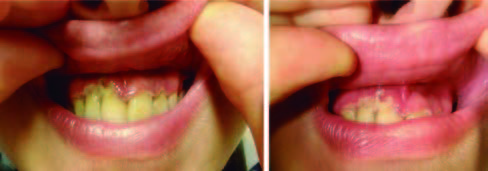A previously healthy seventeen-year-old male, with intermittent smoking habits, presented to the emergency department with a 3-day history of gingival pain, with progressive aggravation. He denied fever, gingival bleeding or other symptoms. No history of recent infection was reported. He reported poor dental care.

Figure 1: Acute necrotizing ulcerative gingivitis in adolescent. Gengival ulcerations with necrotic slough and pseudomembrane formation along the gingival margins.
Examination revealed gingival ulcerations with necrotic slough and pseudomembrane formation along gingival margins of the upper teeth (Fig. 1), accompanied by fetid breath. The rest of the examination was unremarkable. Orthopantomography showed an extensive caries of 1.6 and bone loss of the upper anterior sector (Fig. 2). Diagnosis of acute necrotizing ulcerative gingivitis (ANUG) was established, and surgical gingival debridement performed. He received metronidazole 2 g/day during 10 days and regular oral mouthwash with chlorhexidine, with clinical resolution. He is currently in a smoking cessation program.
Acute necrotizing ulcerative gingivitis is a painful gingivitis with rapid onset. In addition to necrotic gingiva and halitosis, fever and regional lymphadenopathy can be reported. It is caused by a mixed infection with anaerobes and spirochetes. Factors predisposing to development of ANUG include poor oral care, smoking, impaired host immune response, malnutrition, viral infections, stress, and sleep deprivation.1-3 In developed countries ANUG is rare and incidence peaks in late adolescents with smoking habits and poor dental care. Treatment requires local debridement, which usually produces rapid resolution. Adjuvant antibiotic therapy with penicillin or metronidazole for 7 to 10 days, associated with antimicrobial mouthwashes are indicated.4
















